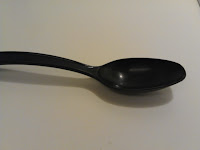 |
| Double Dark Chocolate Gluten-Free, Egg-Free Muffins |
Ok... So as many of you gluten-free eaters out there know, it can be a difficult task to bake a delicious muffin without gluten. It is even more challenging to bake a delicious tender gluten-free muffin without eggs! In most gluten-free baked items, eggs (sometimes in combination with a starch such as tapioca or potato) are used to help bind and create texture due to the lack of gluten dirived texture and binding qualities. When one is not able to use the eggs, even an egg substitute falls short of this huge responsibility many times.
It took many tries, but finally I was able to acheive a muffin that is gluten-free, egg-free, free of hydrogenated fats, but yet rich, delicious and moist.
DRY INGREDIENTS:
2/3 c. Dark Cocoa Powder, (we like Hershey's Special Dark... and it works ok with all the allergies we deal with!)
1 c. Buckwheat Flour
3/4 c. Masa Harina
1 1/4 c. Brown Sugar
1 tsp. Baking Powder
1 tsp. Baking Soda
3/4 tsp. salt
WET INGREDIENTS:
1/2 c. Flaxseed Egg Substitute Mixture* (or two large eggs, if you don't have to avoid them)
1 c. Milk, or your favorite milk substitute (almond milk and coconut milk are both great in this recipe!)
2 tsp. Vinegar
2 tsp. Vanilla Extract
1/4 c. Applesauce, unsweetened
1/4 c. Vegetable or Canola Oil
Optional Add-Ins:
1 c. Dark Chocolate Chips (or other favorite chips)
1/2 c. Coconut, shredded, unsweetened or sweetened
1/2 c. Chopped Pecans
1/2 c. Sunflower Seeds
Or anything else you prefer....
Struesel Topping:
1/4 c. Buckwheat flour (or any GF AP flour mix that you like)
1/2 c. Brown Sugar
2 Tbs. Butter, softened but not melted.
In a large bowl mix together all the Dry Ingredients. Then measure all the Wet Ingredients right into the mixing bowl with the Dry Ingredients. Then mix together well with a whisk until mostly smooth. There is no real need here to mix all the wet ingredient together before adding to the dry as you would with full gluten muffins... there is no gluten in these to make it tough! Just stop mixing when the batter is just about all smooth and you'll be all set! At this point fold in any of the "Optional Add-Ins" that you choose. The muffins pictured above just had the dark chocolate chips added. Scoop the batter into well greased muffin tins (or likewise use cupcake papers...) to about 3/4 full.
If you choose to add the Struesel Topping, simply mix the flour and brown sugar together well, and then cut in the butter with a pastry blender or use your fingers, until it resembles crumbs the size of peas or smaller. Sprinkle this mixture over the uncooked batter and proceed to bake. In the picture shown above, the middle muffin has the Struesel Topping and the two others do not. When I choose to add coconut into the muffin batter (which is absolutely delicious, by the way) I sprinkle the tops with the shredded coconut instead of the struesel topping. It's up to you!
Bake at 425 degrees for about 15-20 minutes. The tops of the muffins should feel firm to the touch. I like to check a couple of the muffins by inserting a wooden skewer or cake tester into the center. If it comes out clean (with the exception of any melted chocolate chips) then they are done! Remove from oven and immediately remove, CAREFULLY, from the muffin tins. Allow to cool for maybe 5 minutes or so.
These muffins are best when served warm. At room temperature they are just a little dryer than when warm, but still quite good. They will keep in an airtight container for 2-3 days, and they freeze extremely well. Put them in the freezer and take out just what you need the night before. Then, at breakfast, warm them in the microwave if you wish, or wrap in foil and warm in a 350 degree oven for about 5-10 minutes while your getting ready for your day!
*Please see the post called "Egg Substitutes" for more information regarding the Flaxseed Egg Substitute. If you are not allergic to eggs, simply use real eggs instead of the substitute.


































